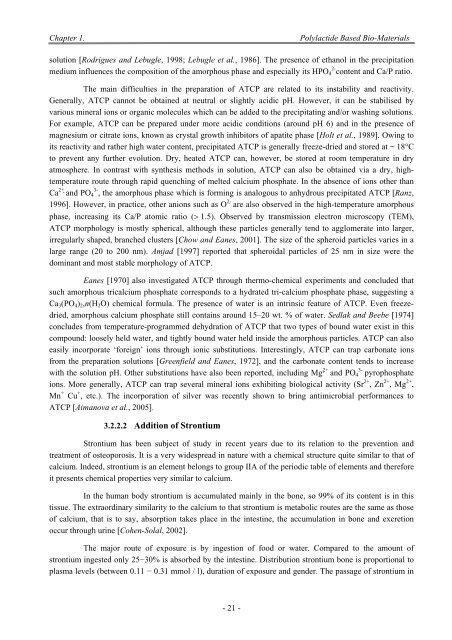Influence of the Processes Parameters on the Properties of The ...
Influence of the Processes Parameters on the Properties of The ...
Influence of the Processes Parameters on the Properties of The ...
You also want an ePaper? Increase the reach of your titles
YUMPU automatically turns print PDFs into web optimized ePapers that Google loves.
Chapter 1.<br />
Polylactide Based Bio-Materials<br />
soluti<strong>on</strong> [Rodrigues and Lebugle, 1998; Lebugle et al., 1986]. <strong>The</strong> presence <str<strong>on</strong>g>of</str<strong>on</strong>g> ethanol in <str<strong>on</strong>g>the</str<strong>on</strong>g> precipitati<strong>on</strong><br />
medium influences <str<strong>on</strong>g>the</str<strong>on</strong>g> compositi<strong>on</strong> <str<strong>on</strong>g>of</str<strong>on</strong>g> <str<strong>on</strong>g>the</str<strong>on</strong>g> amorphous phase and especially its HPO 4 2- c<strong>on</strong>tent and Ca/P ratio.<br />
<strong>The</strong> main difficulties in <str<strong>on</strong>g>the</str<strong>on</strong>g> preparati<strong>on</strong> <str<strong>on</strong>g>of</str<strong>on</strong>g> ATCP are related to its instability and reactivity.<br />
Generally, ATCP cannot be obtained at neutral or slightly acidic pH. However, it can be stabilised by<br />
various mineral i<strong>on</strong>s or organic molecules which can be added to <str<strong>on</strong>g>the</str<strong>on</strong>g> precipitating and/or washing soluti<strong>on</strong>s.<br />
For example, ATCP can be prepared under more acidic c<strong>on</strong>diti<strong>on</strong>s (around pH 6) and in <str<strong>on</strong>g>the</str<strong>on</strong>g> presence <str<strong>on</strong>g>of</str<strong>on</strong>g><br />
magnesium or citrate i<strong>on</strong>s, known as crystal growth inhibitors <str<strong>on</strong>g>of</str<strong>on</strong>g> apatite phase [Holt et al., 1989]. Owing to<br />
its reactivity and ra<str<strong>on</strong>g>the</str<strong>on</strong>g>r high water c<strong>on</strong>tent, precipitated ATCP is generally freeze-dried and stored at ~ 18°C<br />
to prevent any fur<str<strong>on</strong>g>the</str<strong>on</strong>g>r evoluti<strong>on</strong>. Dry, heated ATCP can, however, be stored at room temperature in dry<br />
atmosphere. In c<strong>on</strong>trast with syn<str<strong>on</strong>g>the</str<strong>on</strong>g>sis methods in soluti<strong>on</strong>, ATCP can also be obtained via a dry, hightemperature<br />
route through rapid quenching <str<strong>on</strong>g>of</str<strong>on</strong>g> melted calcium phosphate. In <str<strong>on</strong>g>the</str<strong>on</strong>g> absence <str<strong>on</strong>g>of</str<strong>on</strong>g> i<strong>on</strong>s o<str<strong>on</strong>g>the</str<strong>on</strong>g>r than<br />
Ca 2+ and PO 3- 4 , <str<strong>on</strong>g>the</str<strong>on</strong>g> amorphous phase which is forming is analogous to anhydrous precipitated ATCP [Ranz,<br />
1996]. However, in practice, o<str<strong>on</strong>g>the</str<strong>on</strong>g>r ani<strong>on</strong>s such as O 2- are also observed in <str<strong>on</strong>g>the</str<strong>on</strong>g> high-temperature amorphous<br />
phase, increasing its Ca/P atomic ratio (1.5). Observed by transmissi<strong>on</strong> electr<strong>on</strong> microscopy (TEM),<br />
ATCP morphology is mostly spherical, although <str<strong>on</strong>g>the</str<strong>on</strong>g>se particles generally tend to agglomerate into larger,<br />
irregularly shaped, branched clusters [Chow and Eanes, 2001]. <strong>The</strong> size <str<strong>on</strong>g>of</str<strong>on</strong>g> <str<strong>on</strong>g>the</str<strong>on</strong>g> spheroid particles varies in a<br />
large range (20 to 200 nm). Amjad [1997] reported that spheroidal particles <str<strong>on</strong>g>of</str<strong>on</strong>g> 25 nm in size were <str<strong>on</strong>g>the</str<strong>on</strong>g><br />
dominant and most stable morphology <str<strong>on</strong>g>of</str<strong>on</strong>g> ATCP.<br />
Eanes [1970] also investigated ATCP through <str<strong>on</strong>g>the</str<strong>on</strong>g>rmo-chemical experiments and c<strong>on</strong>cluded that<br />
such amorphous tricalcium phosphate corresp<strong>on</strong>ds to a hydrated tri-calcium phosphate phase, suggesting a<br />
Ca 3 (PO 4 ) 2 ,n(H 2 O) chemical formula. <strong>The</strong> presence <str<strong>on</strong>g>of</str<strong>on</strong>g> water is an intrinsic feature <str<strong>on</strong>g>of</str<strong>on</strong>g> ATCP. Even freezedried,<br />
amorphous calcium phosphate still c<strong>on</strong>tains around 15–20 wt. % <str<strong>on</strong>g>of</str<strong>on</strong>g> water. Sedlak and Beebe [1974]<br />
c<strong>on</strong>cludes from temperature-programmed dehydrati<strong>on</strong> <str<strong>on</strong>g>of</str<strong>on</strong>g> ATCP that two types <str<strong>on</strong>g>of</str<strong>on</strong>g> bound water exist in this<br />
compound: loosely held water, and tightly bound water held inside <str<strong>on</strong>g>the</str<strong>on</strong>g> amorphous particles. ATCP can also<br />
easily incorporate ‘foreign’ i<strong>on</strong>s through i<strong>on</strong>ic substituti<strong>on</strong>s. Interestingly, ATCP can trap carb<strong>on</strong>ate i<strong>on</strong>s<br />
from <str<strong>on</strong>g>the</str<strong>on</strong>g> preparati<strong>on</strong> soluti<strong>on</strong>s [Greenfield and Eanes, 1972], and <str<strong>on</strong>g>the</str<strong>on</strong>g> carb<strong>on</strong>ate c<strong>on</strong>tent tends to increase<br />
with <str<strong>on</strong>g>the</str<strong>on</strong>g> soluti<strong>on</strong> pH. O<str<strong>on</strong>g>the</str<strong>on</strong>g>r substituti<strong>on</strong>s have also been reported, including Mg 2+ and PO 4<br />
3-<br />
pyrophosphate<br />
i<strong>on</strong>s. More generally, ATCP can trap several mineral i<strong>on</strong>s exhibiting biological activity (Sr 2+ , Zn 2+ , Mg 2+ ,<br />
Mn + Cu + , etc.). <strong>The</strong> incorporati<strong>on</strong> <str<strong>on</strong>g>of</str<strong>on</strong>g> silver was recently shown to bring antimicrobial performances to<br />
ATCP [Aimanova et al., 2005].<br />
3.2.2.2 Additi<strong>on</strong> <str<strong>on</strong>g>of</str<strong>on</strong>g> Str<strong>on</strong>tium<br />
Str<strong>on</strong>tium has been subject <str<strong>on</strong>g>of</str<strong>on</strong>g> study in recent years due to its relati<strong>on</strong> to <str<strong>on</strong>g>the</str<strong>on</strong>g> preventi<strong>on</strong> and<br />
treatment <str<strong>on</strong>g>of</str<strong>on</strong>g> osteoporosis. It is a very widespread in nature with a chemical structure quite similar to that <str<strong>on</strong>g>of</str<strong>on</strong>g><br />
calcium. Indeed, str<strong>on</strong>tium is an element bel<strong>on</strong>gs to group IIA <str<strong>on</strong>g>of</str<strong>on</strong>g> <str<strong>on</strong>g>the</str<strong>on</strong>g> periodic table <str<strong>on</strong>g>of</str<strong>on</strong>g> elements and <str<strong>on</strong>g>the</str<strong>on</strong>g>refore<br />
it presents chemical properties very similar to calcium.<br />
In <str<strong>on</strong>g>the</str<strong>on</strong>g> human body str<strong>on</strong>tium is accumulated mainly in <str<strong>on</strong>g>the</str<strong>on</strong>g> b<strong>on</strong>e, so 99% <str<strong>on</strong>g>of</str<strong>on</strong>g> its c<strong>on</strong>tent is in this<br />
tissue. <strong>The</strong> extraordinary similarity to <str<strong>on</strong>g>the</str<strong>on</strong>g> calcium to that str<strong>on</strong>tium is metabolic routes are <str<strong>on</strong>g>the</str<strong>on</strong>g> same as those<br />
<str<strong>on</strong>g>of</str<strong>on</strong>g> calcium, that is to say, absorpti<strong>on</strong> takes place in <str<strong>on</strong>g>the</str<strong>on</strong>g> intestine, <str<strong>on</strong>g>the</str<strong>on</strong>g> accumulati<strong>on</strong> in b<strong>on</strong>e and excreti<strong>on</strong><br />
occur through urine [Cohen-Solal, 2002].<br />
<strong>The</strong> major route <str<strong>on</strong>g>of</str<strong>on</strong>g> exposure is by ingesti<strong>on</strong> <str<strong>on</strong>g>of</str<strong>on</strong>g> food or water. Compared to <str<strong>on</strong>g>the</str<strong>on</strong>g> amount <str<strong>on</strong>g>of</str<strong>on</strong>g><br />
str<strong>on</strong>tium ingested <strong>on</strong>ly 25−30% is absorbed by <str<strong>on</strong>g>the</str<strong>on</strong>g> intestine. Distributi<strong>on</strong> str<strong>on</strong>tium b<strong>on</strong>e is proporti<strong>on</strong>al to<br />
plasma levels (between 0.11 − 0.31 mmol / l), durati<strong>on</strong> <str<strong>on</strong>g>of</str<strong>on</strong>g> exposure and gender. <strong>The</strong> passage <str<strong>on</strong>g>of</str<strong>on</strong>g> str<strong>on</strong>tium in<br />
- 21 -

















